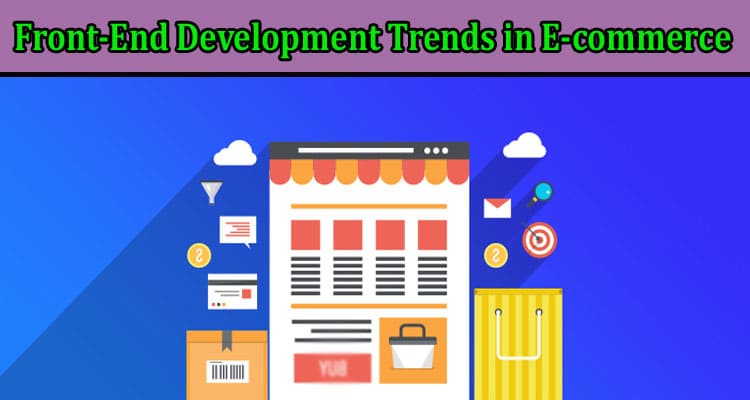In the dynamic world of e-commerce, staying ahead of the curve is crucial for startups to establish a strong online presence and thrive in the competitive market. Front-end development plays a pivotal role in shaping the user experience, and being aware of the latest trends is essential for startups to create visually appealing, responsive, and user-friendly interfaces. In this article, we will explore the key front-end development trends in e-commerce that startups need to be aware of to stay relevant and provide a seamless online shopping experience for their customers.
Responsive Web Design
Responsive web design remains a fundamental trend in front-end development, especially in e-commerce. With an increasing number of users accessing online stores through various devices such as smartphones, tablets, and desktops, it is imperative for startups to ensure that their websites are seamlessly responsive. Google’s emphasis on mobile-first indexing further underscores the importance of having a website that adapts and functions optimally across different screen sizes.
For businesses seeking to stay ahead in the competitive e-commerce landscape, hiring skilled e-commerce developers is essential to implement and maintain responsive web design that caters to diverse user devices. Explore your options at https://lemon.io/hire-ecommerce-developers/.
Progressive Web Apps (PWAs)
PWAs are gaining prominence in the e-commerce space due to their ability to combine the best of both web and mobile applications. These apps offer a fast, reliable, and engaging user experience, making them an attractive choice for startups looking to enhance user engagement and retention. PWAs enable offline access, push notifications, and a smooth browsing experience, contributing to improved customer satisfaction and increased conversion rates.
Single Page Applications (SPAs)
SPAs have become a go-to approach for front-end development in e-commerce. By loading a single HTML page and dynamically updating content as the user interacts with the application, SPAs provide a seamless and uninterrupted browsing experience. This approach not only enhances speed but also reduces server load, making it an efficient choice for e-commerce startups aiming to deliver a fast and responsive shopping experience.
Voice Search Integration
As voice-enabled devices become increasingly popular, integrating voice search functionality into e-commerce websites is a trend that startups should consider. Voice search not only simplifies the user experience but also caters to a growing segment of users who prefer hands-free interactions. Implementing voice search capabilities requires a focus on natural language processing and optimization for spoken queries, ensuring that users can find products effortlessly.
Augmented Reality (AR) and Virtual Reality (VR)
AR and VR technologies are transforming the way users interact with products online. Startups can leverage AR to provide customers with virtual try-on experiences for clothing and accessories, or visualize furniture and home decor items in their living spaces. Implementing AR and VR not only enhances the overall shopping experience but also reduces the uncertainty associated with online purchases, contributing to higher customer satisfaction and lower return rates.
Microinteractions and Animations
Microinteractions and animations add a layer of interactivity to e-commerce websites, making them more engaging and visually appealing. From subtle hover effects to animated product showcases, incorporating microinteractions can enhance the overall user experience. However, it’s crucial for startups to strike a balance between creativity and performance optimization, ensuring that animations do not compromise the site’s loading speed.
Personalization and Artificial Intelligence (AI)
Personalizing the user experience based on individual preferences is a trend that continues to gain traction. By leveraging AI algorithms, startups can analyze user behavior, predict preferences, and offer personalized product recommendations. Personalization enhances customer satisfaction, increases the likelihood of conversions, and fosters brand loyalty. E-commerce startups should explore AI-powered tools to create a more tailored and relevant shopping experience for their customers.
Accessible Design
Ensuring that your e-commerce website is accessible to users with disabilities is not only a legal requirement but also a crucial aspect of providing an inclusive user experience. Startups should prioritize accessible design practices, including proper semantic HTML, keyboard navigation, and compatibility with screen readers. Making your website accessible not only expands your potential customer base but also aligns with ethical and inclusive business practices.
Closure
Staying informed about the latest front-end development trends in e-commerce is essential for startups aiming to build a successful online presence. From responsive design to emerging technologies like AR and VR, the evolving landscape offers numerous opportunities for innovation and differentiation. By embracing these trends, startups can create visually stunning, user-friendly, and feature-rich e-commerce platforms that not only meet but exceed customer expectations in an ever-changing digital landscape. As technology continues to evolve, staying adaptable and incorporating these trends into your front-end development strategy will be key to thriving in the competitive e-commerce industry.

